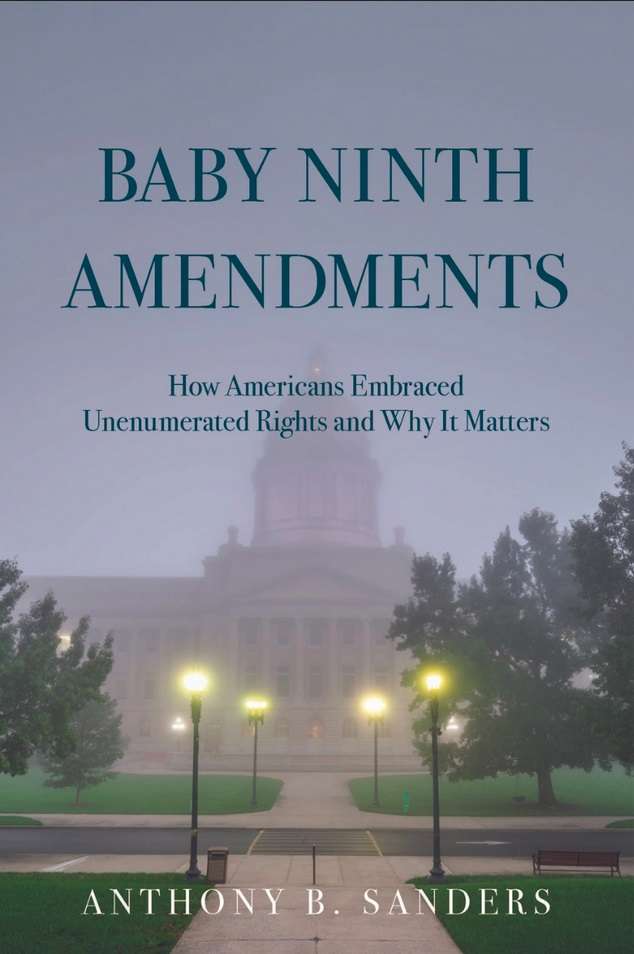Thank you to Eugene and the rest of the Volokh Conspiracy for allowing me to post about my new book published by University of Michigan Press, Baby Ninth Amendments: How Americans Embraced Unenumerated Rights and Why It Matters. I’ve been a VC reader since my second year of law school (which was also the VC’s second year!) and it’s an honor to have this opportunity.
My book tells the largely unknown story of how Americans have solved a problem: How do we enumerate rights when we have an infinite number of them?
I start with a thought experiment involving an average American named Jane. Jane goes about her day making choices for herself and her family on her own terms. Some of these choices are pretty mundane: She chooses when to get up, what to eat, and what hobbies to pursue (gardening and stamp collecting in her case). Some are pretty important: She goes to work at a job that she chose over other options, sends her child to a school she chose, and repairs part of her house with her own labor.
Think about your own day. You make all kinds of similar choices that you think are best for you and those close to you.
But then Jane’s state legislature passes a law that restricts or even forbids one of those choices. Jane is outraged. She can’t believe those know-nothing politicians have done this! Two examples I give, that happened in real life, are prohibiting private schools (Oregon) and banning the growing of vegetables in front yards (Miami Shores, Florida).
Jane isn’t a lawyer but she knows that in America we have our constitutional rights and that this law has to violate one of them. How could it not? She also is savvy enough to know that, in addition to the U.S. Constitution, every state has its own constitution. So she sits down with both the federal version and her state’s constitution and looks at the bill of rights in each. (All 50 state constitutions have their own bill or declaration of rights. To learn more in general check out Judge Jeffrey Sutton’s excellent books.)
In the federal bill of rights, Jane sees what we’ve all heard about: Speech, the press, religious freedom, search and seizure protections, and all the rest. But notice that of the examples of choices I gave above, there’s nothing in the federal bill of rights explicitly protecting them. She also reviews her state bill of rights. Even though it is likely a bit longer than the federal version, it doesn’t specifically address the right she’s concerned about either.
In fact, almost no state constitution “enumerates” any of the choices above, such as a right to garden or a right to earn a living (with a handful of exceptions). Thus, Jane seems to be out of luck.
“What kind of a hatchet job is this?!” she screams. “When they put these constitutions together they protected a few rights, sure, but couldn’t be bothered to name a few more? What about people like me?”
Jane has a point, of course. Some of these rights, such as the right to earn a living, are obviously very important. Some are kind of quirky these days (stamp collecting?), but they still are important to a lot of people.
Then, depressed, Jane glances down to the end or near the end of both bills of rights. Something catches her eye. At item number nine in the federal version she sees this sentence, and a very similar sentence in the state bill of rights: “The enumeration in the Constitution, of certain rights, shall not be construed to deny or disparage others retained by the people.”
“Wow!” Jane exclaims. “This must mean that there are other rights beyond just the enumerated ones and that they’re protected. So to defend myself against this new, terrible, law I just need to argue that my right is a right ‘retained by the people.'” Right?
And that’s the question that my book tries to answer. When it comes to state constitutions.
Many VC readers may know about the debate over what the Ninth Amendment (quoted above) means. Almost entirely ignored by the Supreme Court, arguments have nevertheless raged over the years over whether it protects unenumerated individual rights beyond those in the first eight amendments, or whether it does something else, like protect federalism or collective rights. For example, conspirator Randy Barnett has argued the former while Professor Kurt Lash, has, in good faith, argued otherwise.
My book isn’t about that debate, although I do draw from it. Rather, I examine what that same language means when it’s put in a state constitution. And this isn’t an academic worry. State constitutions can protect your rights against state and local governments just as much as the U.S. Constitution. And often more. I understand most people who follow law and politics are focused on the federal government these days. But in the United States, as a practical matter, most of the time when you’re dealing with a government’s restriction on your liberty it’s state or local government wielding that power, whether it’s an occupational license, a zoning law, a food sales restriction, a building permit, or the whims of a police officer or planning bureaucrat.
Thirty-three states have one of these “Baby Ninth Amendments.” I argue that whatever you think of the Ninth Amendment itself, when it comes to the states Baby Ninth Amendments are a kind of “etcetera clause.” Constitution drafters list some important rights but realize that they can’t list them all in their infinite variety. So over the course of American history, they took the language of the Ninth Amendment and put it in their state constitutions to do just that. In Part II, I’ll summarize the history of how this came to be, with the first Baby Ninths in 1819 all the way to the latest in 1970.
So how have these provisions been interpreted over the years? The people who actually put them in state constitutions thought they would protect unenumerated rights. Judges, on the other hand, generally haven’t done their job of enforcing them. But there are exceptions. I’ll discuss this side of the history in Part III.
What kinds of rights do Baby Ninths protect? That I’ll largely leave for Part IV. They protect natural rights—rights “retained by the people”—such as the ones Jane was worried about. They don’t, however, protect positive rights or procedural rights.
Finally, in Part V we’ll look at how Baby Ninths protect us at a practical level, but also what their larger lesson is. And it’s this: Unenumerated rights aren’t weird, as the U.S. Supreme Court often seems to think. Unenumerated rights, in fact, are normal. They’re popular! They’re as American as apple pie and we should celebrate them as much.
That’s all for now. In the meantime you can order a physical copy of my book online (Amazon or likely for less money from the publisher—use code UMS23 for 30% off!). You can also download an electronic copy for free (a price I very much am a fan of), either on Kindle or as a direct download here.
The post Baby Ninth Amendments Part I: Infinite Rights, Finite Ink appeared first on Reason.com.







